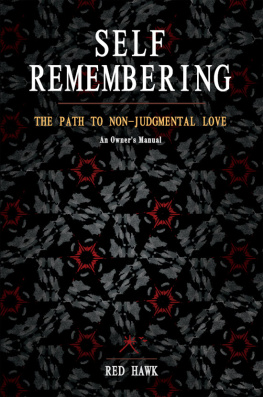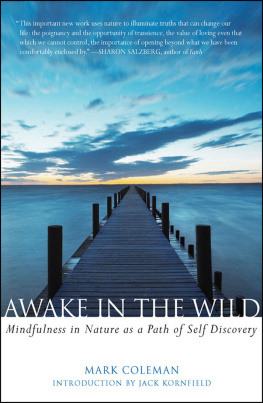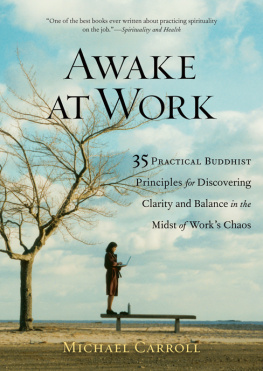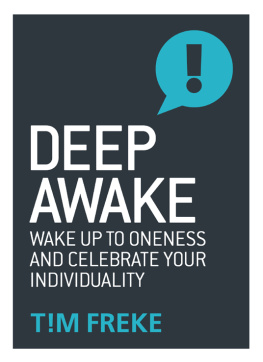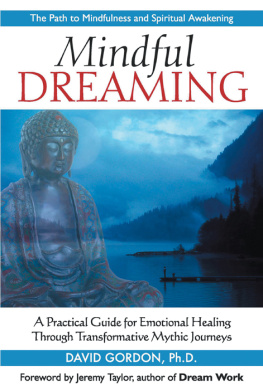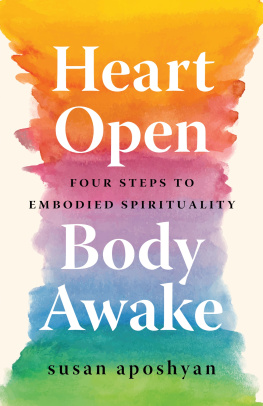About the Author
R ED H AWK was the Hodder Fellow at Princeton University and currently teaches at the University of Arkansas at Monticello.
Red Hawk may be contacted at moorer@uamont.edu
About Hohm Press
H OHM P RESS is committed to publishing books that provide readers with alternatives to the materialistic values of the current culture, and promote self-awareness, the recognition of interdependence, and compassion. Our subject areas include parenting, transpersonal psychology, religious studies, womens studies, the arts and poetry.
Contact Information
Hohm Press, PO Box 4410, Chino Valley, Arizona, 86323; USA; 800-381-2700, or 928-636-3331; email: hppublisher@cableone.net
Visit our website at www.hohmpress.com

CHAPTER 1
Self Remembering:
The Practice of Presence
[He is] talking about everyone being mostly disembodied, about not really having a body. Now how ridiculous is that?... But suddenly I see what hes saying. Yeah, theres a body, but I dont have a conscious awareness of it... [He is] talking again about redirecting the attention out of the head brain, amping up the bodys vibration, becoming embodied.
William Patrick Patterson, 221.
Remember yourself, seeker.
Self observation is absolutely essential if I wish to know myself and mature into a human being and not remain on the mammal level of existencean unconscious, habit driven, mechanical , automatic-pilot slave to my personal history and to unconscious forces derived from that history ( see : Red Hawk. Self Observation: The Awakening of Conscience. An Owners Manual ). Self observation and self remembering are not two separate practices; they are essential and bonded steps in the same practice. Self remembering must come first, then self observation may follow, as the seed must come before the plant can grow. Without self remembering, all so-called self observation is in the mind alone and therefore vulnerable to imagination and illusion, a part of the unconscious dreaming mechanism. Observation from the mind alone goes nowhere, produces fantasy and inner division, and may do harm or produce inner pathology. The destination is the presentit must be constantly renewed with every breath or the connection is lost.
Self remembering places the observer in time and space, in the present, in the body, grounds the observation in the body. The present is the destination for work on self . Unless the body is brought into play in self observation, the practice goes nowhere. At its most fundamental level, first-stage self remembering is remembering that I have a body and exist for a time in this body: I am here now.
Self observation from the mind alone can result in harmful pathology. Every spiritual path has a pathology. One pathology associated with self observation is a self-centered self-obsession (which is why the practice of self remembering involves not just self, but the other). I wish to work with the mind, not from the mind. Working from, or in, the mind alone produces a schism, an inner separation whereby I begin to judge and work against what I observe, rather than with what is observed and for my inner aims I fight with what is observed, under the delusion that I can change what I see. This fight to change what is observed produces wrong results, often harmful, and leads me in a wrong direction from which I may never recover.
As I come to know myself as a mechanical entity, taken constantly in identification in me so that I do not forget my habitual unconsciousness. This accumulation of impressions provides a force behind my wish to remain present. Only then will my resistance to being taken by habit help me see and feel my slavery more.
Split Attention
But self remembering has another aspect to it which is quite unusual among all of the worlds spiritual paths: self remembering, as Mister Gurdjieff taught us, means to split ones Attention, directing one portion of it toward, and including, the surrounding external environment, or the person in front of whom I stand, and the other portion of the Attention is directed onto myselfat the same timeso that I not only listen to, and am aware of, the other but I am aware of myself listening.
Attention is in the body, and on the body in the form of sensation , while it is also on the external environment. Madame Jeanne de Salzmann (Gurdjieffs senior student and the author of The Reality of Being: The Fourth Way of Gurdjieff ) gives this ratio: 75 percent Attention inward, 25 percent Attention external. This quality of split Attention is only possible with conscious laborit does not, cannot, occur mechanically or by accident. It is what is meant, on one level, by conscious labor. Just as the placement of Attention at the solar plexus or abdominal region is a conscious move, and is the most fundamental level of self remembering, so too is the splitting of Attention, which is second-stage self remembering.
Placement of Attention Is Destiny
What I place my Attention on, I become. This is a law. It is the law of identification. Conscious placement of Attention escapes the law of identification and places me under the laws of the Work . We are governed by laws of a higher and lower order. Our work is to place ourselves under the influence of those higher laws.
Conscious Attention is different from automatic, mechanical attention, which we are born with. Conscious Attention must be developed consciously. Attention is the key to this and to human life on earth. The Being the cause of the great majority of our suffering. Thus, it is the most fundamental level of self remembering.
But this struggle to be present is not so simple; it appears easy, but in fact is nearly impossible to do. I cannot remain present in the now of the body for more than a few seconds, but then I have an inner reaction to impressions and I am taken in identification with thought or emotion at once. This is because being present in the body is a different state of consciousness than I have been accustomed to. It is the waking state. It takes a long time to become accustomed to this new, higher state of consciousness. I do not see that Attention is taken by identification for a long time. I believe that I am present. Continued self observation reveals otherwise. What is more, I do not see that I want to be taken, because the fear of seeing the horror of my real inner state is overwhelming and I would rather be distracted, constantly. I cannot remain present because Presence and Attention are both weak in me; they are not developed. That is why I am given a body: to develop these two things which are the essential qualities of the I-am feedback mechanism meant to orient the Being in the present. The destination of the Work is the present; one of the aims of the Work is to develop Presence and Attention to the point where they are stable enough to withstand the shock of physical death of the body and remain present, without being scattered and taken in identification. We work in life to practice our dying.
Formatory Apparatus
Mind, as we ordinarily know and use it, is memoryor what Mister Gurdjieff calls formatory apparatus. There is more to mind than this, of course; only ten percent of the left hemisphere is memory function and this is the thinker. So when I say mind it is a very restricted and specific function, this thinker of which I speak.
The thinker, as we know it, is memory, the storehouse of my personal history. All thought (not inspiration or intuition, which are higher intellectual and emotional functions and are another order of thinking entirely) is memory recalling personal history. All thought is from the known, which is the past, or personal history. The thinker and the thought are the same (J. Krishnamurti). So all self observation which comes from mind alone is the thinker observing itself, judging what it sees, and trying to change itself, based only and exclusively on what is known: the past, personal history. Thus, there is only repetition of habit, doing the same things and hoping for different results. This is insanity.

